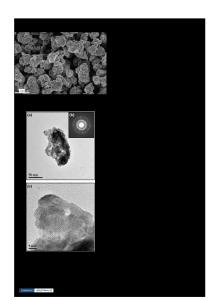Synthesis of WSe 2 Nanorods by Selenium Powder Precursor for Photocatalytic Application and Fuel Additive
- PDF / 1,675,145 Bytes
- 13 Pages / 595.276 x 790.866 pts Page_size
- 93 Downloads / 371 Views
(0123456789().,-volV)(0123456789(). ,- volV)
ORIGINAL PAPER
Synthesis of WSe2 Nanorods by Selenium Powder Precursor for Photocatalytic Application and Fuel Additive Saba Jamil1,2
· Fiza Farooq2 · Shanza Rauf Khan2 · Muhammad Ramzan Saeed Ashraf Janjua3
Received: 29 May 2020 © Springer Science+Business Media, LLC, part of Springer Nature 2020
Abstract By reducing the size of semiconductor material up to nanoscale, the physical and chemical properties vary substantially, resulting in unique features due to their large surface area or the quantum size. Tungsten selenide (WSe2) nano semiconductor is synthesized by a solvothermal method using sodium tungstate and selenium powder as a precursor, PVP as a stabilizing agent, and urea as a precipitating agent. Structural information of material is elucidated by XRD, such as grain size and crystal orientation. Diffraction peaks are observed at 13.69°, 31.45°, 37.93°, 41.27°, 47.53°, 55.47°, 55.95° and 65.17° 2θ values which designate the (002), (100), (103), (006), (105), (110), (112) and (200), miller indices respectively. The XRD result shows that the structure of semiconducting nanoparticles is hexagonal in shape and purely crystalline. The SEM determined surface topography and morphology of material that particles are rod-like, and the average particle size of nanorods is 41 nm. By Fuel additive application, it is clear that WSe2 nano semiconductor dramatically affects the fuel’s properties and different parameters analyze its efficiency, i.e., fire and flash point, cloud and pour point, kinematic viscosity, specific gravity and calorific values. The previous research has shown that semiconducting nanoparticles are essential in degrading dyes from water. At nanoscale, WSe2 nano semiconductor has recently been developed as an efficient photocatalyst because of its attractive band gap estimated as 1.8609 eV. WSe2 is an excellent catalyst because that Kapp values increase linearly from 0.0023 to 0.0037 min−1 with increase in catalyst dose from 0.01 to 0.05 g. In addition, it behaves as a good additive because the calorific value increased from 10,263 to 31,930 Jg−1 by the increase in additive dose from 20 to 80 ppm.
Electronic supplementary material The online version of this article (https://doi.org/10.1007/s10876-020-01874-9) contains supplementary material, which is available to authorized users. & Saba Jamil [email protected] & Muhammad Ramzan Saeed Ashraf Janjua [email protected] 1
Department of Materials Science and Engineering, Cornell University, Ithaca, NY 14853, USA
2
Super Light Materials and Nanotechnology Laboratory, Department of Chemistry, University of Agriculture, Faisalabad 38000, Pakistan
3
Department of Chemistry, King Fahd University of Petroleum and Minerals, Dhahran 31261, Kingdom of Saudi Arabia
123
S. Jamil et al.
Graphic Abstract
Keywords Nano semiconductor · WSe2 Nanorods · Photo-catalysis · Congo red · Fuel additive
Introduction Nanoparticles have a tiny size and their physical [1], optical [2], thermal [3], chemical [4] and ca
Data Loading...











